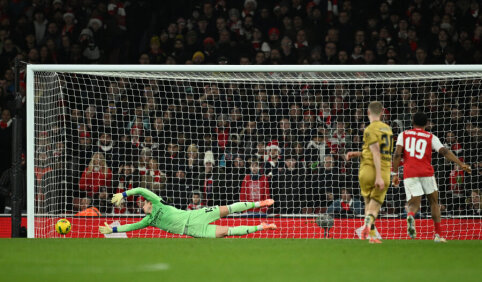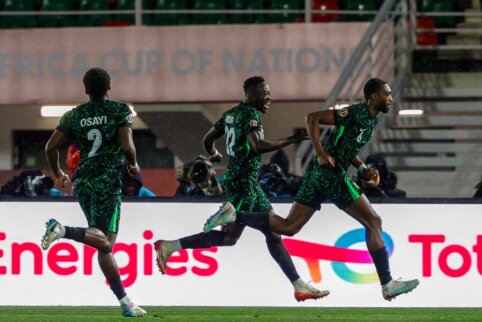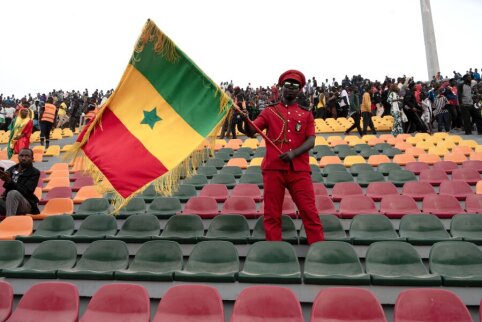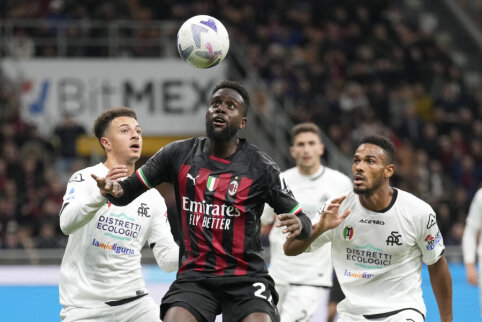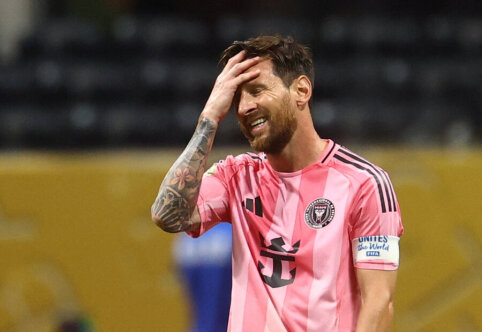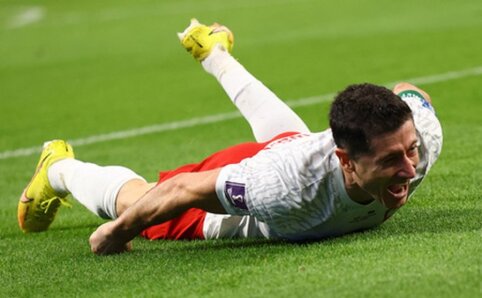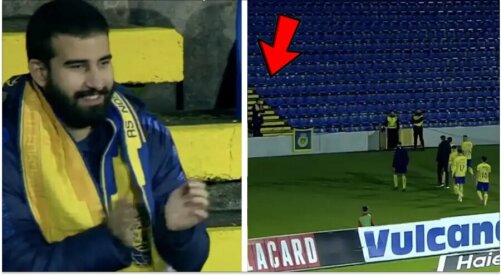 © EuroFootball.com
© EuroFootball.com
In the section of the Tribune - an interesting article for fans of Lithuanian football. On the official website of Gargždų "Bangos" club, already printed an article about the attendance of Lithuanian football matches, which is analyzed using statistics and comparison with other European countries, EuroFootball.com visitors are offered by its author Remigijus.
Have you heard of a team called "Macclesfield Town"? Most likely, not. Nothing strange, as probably many English people don't know this club playing in the 4th league of England. Another strange thing is that more spectators come to the matches of this club than to any football club in Lithuania.
The 2006 football season has ended - it's time to count all the visitors at football stadiums and evaluate the attendance indicators of the strongest Lithuanian football clubs.
Statistics. There is an old saying that there are three levels of lies: a simple lie, a bold lie, and statistics. The number of spectators in match protocols is one of the most controversial indicators. For example, a newspaper reviewing a match of a "A League" club almost always noted a number of spectators 2-3 times smaller than the match inspector in the protocol. Now it's difficult to say which side is right. It may be that the truth is somewhere in between. In any case, even if we cannot trust the numbers presented in the match protocols, we won't find information from other sources. Just by looking at the numbers below, we should at least acknowledge to ourselves that there were about ten percent fewer spectators.
Let's recall that in the matches of the I League in the 2006 season, 39629 fans attended (an average of 129 spectators per match). The number of fans in the "A League" seems more solid - 115606 fans (an average of 642 per match). The "Šiauliai" can boast of the largest number of fans. Almost 21 thousand fans watched the matches at the stadium in Šiauliai (an average of 1163 per match). The Marijampolė "Sūduva" was not far behind the people of Šiauliai - 19335 fans (an average of 1074 per match). Meanwhile, neither the former nor the new champions of Lithuania - Panevėžio "Ekranas" and "FBK Kaunas" - failed to exceed a thousand fans per match (960 and 801 respectively). The three Vilnius clubs compete not only on the football field but also in the stands. So far, "Žalgiris" is in front (an average of 696 spectators), but followed by "Vėtra" (662). Meanwhile, "Vilnius" had the opportunity to see that the Brazilian invasion guarantees neither victories on the football field nor a crowd of fans in the stands. The third capital club was managed to surpass even the Visagino "Interas" playing in the I League (an average of 465 spectators in Visaginas and 428 in Vilnius). The "Brazilian" club was not even saved by the "help" of the other two capital clubs. The most popular matches in "Vilnius" - derbies with "Žalgiris" and "Vėtra", when a significant part of the audience was made up of fans of the rivals.
Another I League club - Gargždų "Banga" broke into the top ten most visited clubs. The people of Gargždai (an average of 366 spectators) surpassed not only the outsiders of the "A League," "Nevėžis" and "Šilutė," but also their closest neighbor - Klaipėda's "Atlantas" (an average of 342 spectators). The "Šilutė" remaining in the 9th place in the "A League" (an average of 195 spectators) fell behind not only "Interas" and "Banga" but also Alytus "Alytis" (an average of 328 spectators). The saddest should be the Kėdainiai "Nevėžis" - not only did the people of Kėdainiai fall into the I League, but they played the whole season in Kaunas almost without spectators (an average of 101 spectators). According to this indicator, "Nevėžis" is only 16th in Lithuania.
Table 1. Attendance statistics of clubs' matches in A and I Leagues.
(Place, club, league, total fans per season, average per match)
1 Šiaulių "Šiauliai" A 20925 1163
2 Marijampolės "Sūduva" A 19335 1074
3 Panevėžio "Ekranas" A 17275 960
4 Kauno "FBK Kaunas" A 14413 801
5 Vilniaus "Žalgiris" A 12530 696
6 Vilniaus "Vėtra" A 11917 662
7 Visagino "Interas" I 7913 465
8 Vilniaus "Vilnius" A 7710 428
9 Gargždų "Banga" I 6230 366
10 Klaipėdos "Atlantas" A 6162 342
11 Alytaus "Alytis" I 5579 328
12 Šilutės "Šilutė" A 3516 195
13 Pakruojo "Kruoja" I 2821 166
14 Jonavos "Lietava" I 2386 140
15 Plungės "Babrungas" I 1730 102
16 Kėdainių "Nevėžis" A 1823 101
17 Kauno "Rodiklis" I 1705 100
18 Kauno "Kauno jėgeriai" I 1386 82
19 Šiaulių "Šiauliai-2" I 1224 72
20 Marijampolės "Sūduva-2" I 1206 71
21 Vilniaus "Vilnius-2" I 1103 65
22 Kauno "Atletas" I 1028 60
23 Ukmergės "Vilkmergė" I 1015 60
24 Vilniaus "Žalgiris-2" I 916 54
25 Vilniaus "Geležinis vilkas" I 890 52
26 Kauno "LKKA ir Teledema" I 885 52
27 Vilniaus "Vėtra-2" I 875 51
28 Klaipėdos "Atlantas-2" I 737 43
Too much or too little? Comparing Lithuania's results with the attendance figures of football matches in other countries, we cannot objectively say whether to be happy or sad about the number of spectators at football matches. Just looking at the statistics of other European countries does not bring much joy - Lithuania lags behind only Estonia, Luxembourg, and Wales. Our indicators are very similar to those of Latvia. It's even sadder when looking at the attendance figures of football matches in other countries. In the 2005-2006 season in France's top division (Ligue 1) the average attendance was 21576, in Germany (1st Bundesliga) - 40745, in Spain (Primera Division) - 29029, in England (FA Barclays Premiership) - 33864 spectators.
Truth be told, Lithuania cannot even compare with the second-tier leagues of the mentioned countries: France (Ligue 2) - 6496, Germany (2. Bundesliga) - 13124, Spain (Segunda Division) - 6593, England (Coca Cola League Championship) - 17616 spectators. The beginning of the article mentioned an English 4th league club for a reason. In this league, the matches are watched on average by 4194 spectators, and the mentioned "Macclesfield Town" is last in attendance (2275 spectators). Not to mention giants such as "Manchester United" (an average of 68765 spectators - 1st place in England), "Portsmouth" (19840 - 20th place in England), "Barcelona" (73225 - 1st place in Spain), "Getafe" (12763 - 20th place in Spain), or "Marseille" (49625 - 1st place in France).
Of course, there are comforting facts - those countries are large, cities are populous, football there is the most popular sport, while here we have to give way to basketball. Showcasing discrepancies between Lithuania and other countries' attendance numbers at football matches, we cannot say objectively - whether to be happy or sad about the number of spectators at football matches. Just by looking at the first glance at the statistics of other European countries does not bring much joy - Lithuania only surpasses Estonia, Luxembourg, and Wales. Our figures are very similar to those of Latvia. Looking closer at the attendance data from football matches in other countries would be even sadder. In the 2005-2006 season in the top division of Ireland (Eircom Premier League), an average of 1759 spectators attended matches, and in the second division (Eircom First Division) - 523 spectators. Hence - 3-4 times more than in Lithuania. A similar difference can be seen when looking at individual clubs: "Cork City" - 3641, "Derry City" - 2698, "Bohemians" - 1976 spectators, and so on.
Essence. So far, we have mainly looked at absolute numbers, but the actual popularity of football in specific cities is best reflected by another indicator - what share of the city's residents attend football matches. For example, in Marseille (808 thousand inhabitants), the mentioned 49625 spectators make up 6.14 percent of all city residents, in Getafe (156 thousand) - 8.18 percent, in Barcelona (1.6 million) - 4.6 percent, and in "Barcelona" matches come 4.6 percent, and in "Espanyol" matches 1.4 percent (so together - 6 percent). Of course, everyone is beaten by the English: "Liverpool" matches are watched by 10 percent, and the matches of the other city club "Everton" - by 8.3 percent of residents; in Manchester "Manchester United" attracts 15.6 percent, and "Manchester City" attracts even 9.7 percent of residents; "Newcastle" matches are watched by 18.8 percent of Newcastle residents. From 3 to 20 percent of specific city or town residents watch matches of other English league clubs - whether it's the "Carlisle United" playing in the 4th league (10 percent), or in the 2nd league - "Ipswich" (17.3 percent).
Where is football most popular in Lithuania? If we evaluate the attendance of matches in Lithuania using the same principle, we get a slightly different ranking and even less encouraging results (see Table 2).
Table 2. The share of city residents (in percentages) attending football matches.
(Place, club, league, average viewers, city residents, share of residents (in %) at matches)
1. Pakruojo "Kruoja" I 166 6057 2.74
2. Gargždų "Banga" I 366 15212 2.41
3. Marijampolės "Sūduva" A 1074 48675 2.21
4. Visagino "Interas" I 465 29554 1.57
5. Šilutės "Šilutė" A 195 21476 0.91
6. Šiaulių "Šiauliai" A 1163 133883 0.87
7. Panevėžio "Ekranas" A 960 119749 0.80
8. Alytaus "Alytis" I 328 71491 0.46
9. Plungės "Babrungas" I 102 23436 0.43
10. Jonavos "Lietava" I 140 34954 0.40
11. Kėdainių "Nevėžis" A 101 32048 0.32
12. Kauno "FBK Kaunas" A 801 378943 0.21
13. Ukmergės "Vilkmergė" I 60 28759 0.21
14. Klaipėdos "Atlantas" A 342 192954 0.18
15. Marijampolės "Sūduva-2" I 71 48675 0.15
16. Vilniaus "Žalgiris" A 696 553904 0.13
17. Vilniaus "Vėtra" A 662 553904 0.12
18. Vilniaus "Vilnius" A 428 553904 0.08
19. Šiaulių "Šiauliai-2" I 72 133883 0.05
20. Kauno "Rodiklis" I 100 378943 0.03
21. Klaipėdos "Atlantas-2" I 43 192954 0.02
22. Kauno "Kauno jėgeriai" I 82 378943 0.02
23. Kauno "Atletas" I 60 378943 0.02
24. Kauno "LKKA ir Teledema" I 52 378943 0.01
25. Vilniaus "Vilnius-2" I 65 553904 0.01
26. Vilniaus "Žalgiris-2" I 54 553904 0.01
27. Vilniaus "Geležinis vilkas" I 52 553904 0.01
28. Vilniaus "Vėtra-2" I 51 553904 0.01
Who is to blame? There are several correct answers to this classic question. One answer would come from the clubs, another from the football federation or the national football clubs association, and another variant would be presented by the fans. Clubs, of course, would be right to say that the schedule makers are to blame. Can we expect many spectators at matches taking place on a Wednesday or Thursday at 2 pm? Only students, youths, and those parts of the population who are not working at that time are likely to attend. In general, complaints are made that the quality of Lithuanian football stadiums is not great, but for some reason, vacations are taken in July, and games are played in November when the cold and snow are biting the eyes. However, not without faults are the clubs themselves - for years, in Lithuanian football, behind-the-scenes games have been going on (a kind of "top" - an attempt to remove the Panevėžio "Ekranas" from the 2004 championship), making football fans no longer believe that there is a fight to the end in the championships, but rather point exchanges (just read the last three match comments of the "A League" on various football-specific and general internet sites). A good image is built over the decades, but it can be shattered almost overnight. This persistent bleak football image is also contributed by the fact that the article referenced promises of the "mayonnaise era," about the rebirth of football, but for years we have been waking up to the same tune: there is no national stadium, club stadiums resemble fields where spectators can, at best, stand (benches, it seems, the wind blew the warmth away), football match broadcasts start in the middle of the season and end in the middle of the season.
Will it get better? Hope dies last. Some both "A League" and "I League" clubs understand that the most important participant of the football celebration is the fan. Perhaps these clubs will set an example for others. Perhaps the situation will be changed by the restructuring of the I League - on the one hand, smaller town clubs that feel good without spectators will replace duplication teams, and on the other hand, the football league system itself will become clearer, and the 5th and 8th place clubs will no longer claim to be in the "A League." With these hopes, we wait for the next season.
